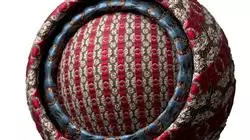University certificate
The world's largest faculty of information technology”
Introduction to the Program
Become an expert in 3D modeling Texturing process, learn how to use the leading tools in this sector"

This University Expert in Texturing is intended to cover the leading tools for this process, such as 3DS Max, Photoshop or ZBrush. The student thus acquires the knowledge he needs to develop as a true expert in Texturing and will be able to generate the effects he wants in his modeling, for example, to achieve hyper-realistic effects in animations for movies, video games, advertising spots and more.
The first area is an introductory preamble of the indispensable concepts for the creation of a model such as Baking, in order to appreciate the greatest amount of detail without losing the performance of the image. The curriculum also delves into Texturing with the Subastance Painter tool, a software that provides a wide range of options when working with hyper-realistic textures.
The educational program also delves into the rendering process, a phase almost as essential as Texturing, which occurs at the end of each model to optimize the image quality and weight of the model. In addition, the rendering achieves deeper design posing, lighting and the highest possible image quality. All this using Marmoset, a pioneer software in the world of digital sculpture.
All the content of this Postgraduate diploma in Texturing is offered in a totally virtual format, favoring the deepening of knowledge at the speed and pace set by the student. This allows us to combine personal and professional projects with the continuous recycling of knowledge. In addition, an expert teaching staff is always available to tutor the student.
Learn how to use state-of-the-art Texturing tools such as 3DS Max, Substance Painter or Marmoset Toolbag"
This Postgraduate diploma in Texturing contains the most complete and up-to-date educational program on the market. Its most notable features are:
- The development of case studies presented by experts in 3D Modeling with 3D Studio Max
- The graphic, schematic and practical contents with which it is conceived provide and practical information on those disciplines that are essential for professional practice.
- Practical exercises where the self-assessment process can be carried out to improve learning
- Its special emphasis on innovative methodologies
- Theoretical lessons, questions to the expert, debate forums on controversial topics, and individual reflection assignments
- Content that is accessible from any fixed or portable device with an Internet connection
Learn how to texture your 3D modeling, as well as how to render them, to specialize and become an expert in the field"
The program’s teaching staff includes professionals from the sector who contribute their work experience to this educational program, as well as renowned specialists from leading societies and prestigious universities.
The multimedia content, developed with the latest educational technology, will provide the professional with situated and contextual learning, i.e., a simulated environment that will provide immersive education programmed to learn in real situations.
This program is designed around Problem-Based Learning, whereby the professional must try to solve the different professional practice situations that arise during the course. For this purpose, students will be assisted by an innovative interactive video system created by renowned and experienced experts.
At your own pace and combining it with other personal and professional projects, that's how easy it is to learn Texturing with this Postgraduate diploma''

Enroll now in this Postgraduate diploma in Texturing and learn the tricks and keys to give a good finish to your 3D designs''
Why study at TECH?
TECH is the world’s largest online university. With an impressive catalog of more than 14,000 university programs available in 11 languages, it is positioned as a leader in employability, with a 99% job placement rate. In addition, it relies on an enormous faculty of more than 6,000 professors of the highest international renown.

Study at the world's largest online university and guarantee your professional success. The future starts at TECH”
The world’s best online university according to FORBES
The prestigious Forbes magazine, specialized in business and finance, has highlighted TECH as “the world's best online university” This is what they have recently stated in an article in their digital edition in which they echo the success story of this institution, “thanks to the academic offer it provides, the selection of its teaching staff, and an innovative learning method aimed at educating the professionals of the future”
A revolutionary study method, a cutting-edge faculty and a practical focus: the key to TECH's success.
The most complete study plans on the university scene
TECH offers the most complete study plans on the university scene, with syllabuses that cover fundamental concepts and, at the same time, the main scientific advances in their specific scientific areas. In addition, these programs are continuously being updated to guarantee students the academic vanguard and the most in-demand professional skills. In this way, the university's qualifications provide its graduates with a significant advantage to propel their careers to success.
TECH offers the most comprehensive and intensive study plans on the current university scene.
A world-class teaching staff
TECH's teaching staff is made up of more than 6,000 professors with the highest international recognition. Professors, researchers and top executives of multinational companies, including Isaiah Covington, performance coach of the Boston Celtics; Magda Romanska, principal investigator at Harvard MetaLAB; Ignacio Wistumba, chairman of the department of translational molecular pathology at MD Anderson Cancer Center; and D.W. Pine, creative director of TIME magazine, among others.
Internationally renowned experts, specialized in different branches of Health, Technology, Communication and Business, form part of the TECH faculty.
A unique learning method
TECH is the first university to use Relearning in all its programs. It is the best online learning methodology, accredited with international teaching quality certifications, provided by prestigious educational agencies. In addition, this disruptive educational model is complemented with the “Case Method”, thereby setting up a unique online teaching strategy. Innovative teaching resources are also implemented, including detailed videos, infographics and interactive summaries.
TECH combines Relearning and the Case Method in all its university programs to guarantee excellent theoretical and practical learning, studying whenever and wherever you want.
The world's largest online university
TECH is the world’s largest online university. We are the largest educational institution, with the best and widest online educational catalog, one hundred percent online and covering the vast majority of areas of knowledge. We offer a large selection of our own degrees and accredited online undergraduate and postgraduate degrees. In total, more than 14,000 university degrees, in eleven different languages, make us the largest educational largest in the world.
TECH has the world's most extensive catalog of academic and official programs, available in more than 11 languages.
Google Premier Partner
The American technology giant has awarded TECH the Google Google Premier Partner badge. This award, which is only available to 3% of the world's companies, highlights the efficient, flexible and tailored experience that this university provides to students. The recognition as a Google Premier Partner not only accredits the maximum rigor, performance and investment in TECH's digital infrastructures, but also places this university as one of the world's leading technology companies.
Google has positioned TECH in the top 3% of the world's most important technology companies by awarding it its Google Premier Partner badge.
The official online university of the NBA
TECH is the official online university of the NBA. Thanks to our agreement with the biggest league in basketball, we offer our students exclusive university programs, as well as a wide variety of educational resources focused on the business of the league and other areas of the sports industry. Each program is made up of a uniquely designed syllabus and features exceptional guest hosts: professionals with a distinguished sports background who will offer their expertise on the most relevant topics.
TECH has been selected by the NBA, the world's top basketball league, as its official online university.
The top-rated university by its students
Students have positioned TECH as the world's top-rated university on the main review websites, with a highest rating of 4.9 out of 5, obtained from more than 1,000 reviews. These results consolidate TECH as the benchmark university institution at an international level, reflecting the excellence and positive impact of its educational model.” reflecting the excellence and positive impact of its educational model.”
TECH is the world’s top-rated university by its students.
Leaders in employability
TECH has managed to become the leading university in employability. 99% of its students obtain jobs in the academic field they have studied, within one year of completing any of the university's programs. A similar number achieve immediate career enhancement. All this thanks to a study methodology that bases its effectiveness on the acquisition of practical skills, which are absolutely necessary for professional development.
99% of TECH graduates find a job within a year of completing their studies.
Postgraduate Diploma in Texturing
Texturing is an essential technique in the world of design and animation, which allows to give life and realism to objects and characters in the digital environment. With the rise of the entertainment industry, texturing has become a highly valued and sought after skill in the field of animation, video games, film and advertising. For this reason, TECH Global University has developed the most complete and up-to-date Postgraduate Diploma in Texturing on the educational market. Our program is focused on offering a complete and up-to-date education on the techniques and tools used in the texturing process. Here, we bet on virtuality as a multifaceted and powerful tool, therefore, our classes are 100% online, structured in intensive learning modules that employ dynamic methodologies. Through the syllabus, you will delve into the fundamentals of texturing, including the understanding of light, color and texture in the real world.
Become a texturing specialist
Texturing is a fundamental part of the process of creating virtual worlds and 3D characters, giving them a realistic and convincing appearance. In this sense, the work of professionals contributes to improve the visual quality of productions. At TECH we focus on providing you with the necessary tools to perform successfully in this field. Through the syllabus, you will delve into advanced digital painting techniques, the use of specialized texturing software and the creation of procedural textures and PBR (Physically Based Rendering). With this new knowledge, you will be able to create realistic and attractive textures on 3D objects and characters, using new tools and techniques. In addition, you will learn to apply design and aesthetic principles to texture creation, which is essential to achieve visually appealing and high-quality results.







